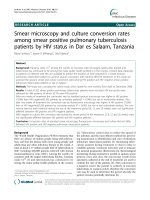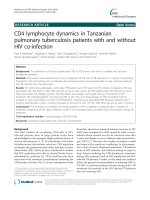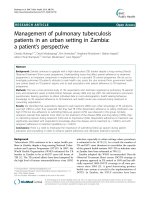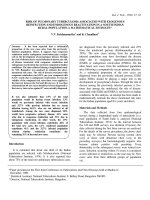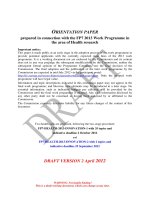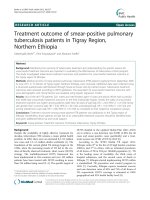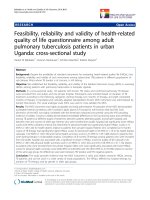Clinical response of newly diagnosed HIV seropositive & seronegative pulmonary tuberculosis patients with the RNTCP Short Course regimen in Pune, India doc
Bạn đang xem bản rút gọn của tài liệu. Xem và tải ngay bản đầy đủ của tài liệu tại đây (352.9 KB, 8 trang )
Clinical response of newly diagnosed HIV seropositive &
seronegative pulmonary tuberculosis patients with the
RNTCP Short Course regimen in Pune, India
S. Tripathy, A. Anand, V. Inamdar, M.M. Manoj
*
, K.M. Khillare
*
, A.S. Datye
*
, R. Iyer
**
,
D.M. Kanoj
*
, M. Thakar, V. Kale, M. Pereira & A.R. Risbud
National AIDS Research Institute (ICMR),
*
Talera Hospital &
**
Pimpri Chichwad
Municipal Corporation, Pune, India
Received January 27, 2010
Background & objectives: In the Revised National Tuberculosis Control Programme (RNTCP) in
India prior to 2005, TB patients were offered standard DOTS regimens without knowledge of HIV
status. Consequently such patients did not receive anti-retroviral therapy (ART) and the inuence of
concomitant HIV infection on the outcome of anti-tuberculosis treatment remained undetermined. This
study was conducted to determine the results of treatment of HIV seropositive pulmonary tuberculosis
patients with the RNTCP (DOTS) regimens under the programme in comparison with HIV negative
patients prior to the availability of free ART in India.
Methods: Between September 2000 and July 2006, 283 newly diagnosed pulmonary TB patients were
enrolled in the study at the TB Outpatient Department at the Talera Hospital in the Pimpri Chinchwad
Municipal Corporation area at Pune (Maharashtra): they included 121 HIV seropositive and 162 HIV
seronegative patients. They were treated for tuberculosis as per the RNTCP in India. This study was
predominantly conducted in the period before the free ART become available in Pune.
Results: At the end of 6 months of anti-TB treatment, 62 per cent of the HIV seropositive and 92 per cent
of the HIV negative smear negative patients completed treatment and were asymptomatic; among smear
positive patients, 70 per cent of the HIV-seropositive and 81 per cent of HIV seronegative pulmonary
TB patients were cured. Considering the results in the smear positive and smear negative cases together,
treatment success rates were substantially lower in HIV positive patients than in HIV negative patients,
(66% vs 85%). Further, 29 per cent of HIV seropositive and 1 per cent of the HIV seronegative patients
expired during treatment. During the entire period of 30 months, including 6 months of treatment and
24 months of follow up, 61 (51%) of 121 HIV positive patients died; correspondingly there were 6 (4%)
deaths among HIV negative patients.
Interpretation & conclusions: The HIV seropositive TB patients responded poorly to the RNTCP regimens
as evidenced by lower success rates with chemotherapy and high mortality rates during treatment and
follow up. There is a need to streamline the identication and management of HIV associated TB
patients in the programme with provision of ART to achieve high cure rates for TB, reducing mortality
rates and ensuring a better quality of life.
Key words Anti-retroviral therapy - HIV - HIV-TB - RNTCP - seropositive - sputum - tuberculosis
521
Indian J Med Res 133, May 2011, pp 521-528
Tuberculosis is a major public health problem
globally as well as regionally. In Asia, the prevalence
of HIV infection in TB patients has been lower than
that reported from sub-Saharan Africa
1
. In urban
areas in India, a series of referral center surveys from
the late 1990’s reported an increasing prevalence of
HIV among TB patients
2-12
Raizada et al
12
provided
information from community based surveys on
tuberculosis patients in different regions of India and
showed a HIV prevalence varying from 1 to 13.8
per cent in 15 different districts in India
12
.
In India,
more than 50 per cent of HIV seropositive subjects
have been shown to develop active tuberculosis at
least once in their lifetime
13,14
. Thus, managing
HIV
associated TB could be a problem in areas where HIV
prevalence is high.
In the Revised National Tuberculosis Control
Programme (RNTCP) in India, the target of 85 per cent
cure rate has been attained. A recent report indicates a
success rate of 87 per cent in 2009
15
. This, however, is
a mean of results achieved throughout the country with
a HIV prevalence of 0.29 per cent
16
.
The distribution of
HIV infection is uneven and there are six States which
have HIV prevalence over 1 per cent. In such areas,
the prevalence of HIV infection in TB patients may
be high, which could in turn affect the efcacy of the
RNTCP regimen.
In the TB Control Programme in India, routine
screening for HIV infection was not being carried out in
tuberculosis patients till recently. Hence, many patients
were being treated for tuberculosis under programme
conditions without knowledge of the presence or
absence of concurrent HIV infection. However, in
high HIV prevalence States, there is a provision for
routine referral of all TB patients for voluntary HIV-
counselling and testing.
The current RNTCP regimens in India are highly
effective in the management of tuberculosis patients
without HIV infection. There was insufcient
information about their efcacy in HIV associated
TB. Hence, the Indian Council of Medical Research
(ICMR), New Delhi, commissioned two Task Force
studies in Pune and Chennai to determine the efcacy of
the directly observed intermittent short course RNTCP
regimens in pulmonary tuberculosis patients having
concurrent HIV infection. The present study reports on
the outcome of the study conducted in Pune.
Material & Methods
This prospective observational study was
undertaken at the Chest Clinic in Talera Hospital
located in the Pimpri Chinchwad area of Pune. This
clinic serves as the District TB Centre (DTC) for the
Pimpri Chinchwad Municipal Corporation (PCMC)
area under the Revised National Tuberculosis Control
Programme of India. The DTC at Talera Hospital has
a good record of implementation of the RNTCP and
is located in an area with a high prevalence of HIV
infection. Between 11 to 31 per cent of the new TB
patients attending the Talera Clinic had concurrent HIV
infection, similar to that reported earlier from other TB
clinics in the Pune region
17
.
The study was initiated after getting approvals
from the institutional Ethics Committee at the National
AIDS Research Institute (NARI). Newly diagnosed
pulmonary tuberculosis patients were tested for
presence of HIV infection after informed consent was
obtained. Subjects with or without HIV infection who
were willing to participate in the study were enrolled,
after obtaining written consent, between September
2000 and July 2006 when the required target for
enrollment in each arm of the study was attained. These
patients had never been treated for TB or had taken
anti-tuberculosis drugs for less than one month. After
enrollment, they were treated with the RNTCP regimen
for 6 to 7 months and were followed up for a period of
two years after the completion of their treatment for
pulmonary tuberculosis with periodic visits at three
monthly intervals. Sputum examination was carried
out at the 2
nd
, 4
th
and 6
th
month as required by RNTCP.
All HIV seropositive pulmonary tuberculosis cases
were treated with Category 1 regimen, while HIV
seronegative patients were treated with either Category
1 or Category III regimens as per RNTCP guidelines.
During the period of anti-TB treatment, if the subject
failed to turn up for treatment, suitable action was
taken as described in the RNTCP to ensure regularity
in anti-TB treatment. At the time of the initiation of the
study, free antiretroviral therapy was not yet available
in India. Whenever a death occurred in the hospital,
the hospital records were reviewed for the cause of
the death. However, if the death occurred outside the
hospital setting, a verbal autopsy was carried out by
discussions with the subject’s relatives or friends.
Diagnosis of active pulmonary tuberculosis: Individuals
with a history of cough of 3 wk duration or more and
not responding to routine line of management for
522 INDIAN J MED RES, MAY 2011
upper respiratory tract infection were advised to give
three sputum samples (usually two spot and one early
morning collection) for sputum smear examination for
acid fast bacilli (AFB) using the Ziehl-Nielsen Method
and the smears were graded as per WHO standards
18
.
Smear positive pulmonary tuberculosis patients
were diagnosed using the following criteria as per the
RNTCP guidelines: (i) Two or three smears positive
for AFB and (ii) One sputum smear positive for AFB
with radiographic abnormalities consistent with active
pulmonary tuberculosis. Smear negative pulmonary
tuberculosis was diagnosed if three sputum smears
were negative for AFB but evidence of radiographic
abnormalities of active tuberculosis was present after
two weeks of antibiotic treatment for routine bacterial
infections of the respiratory tract
19
.
Detection of HIV infection: All patients were given pre-
test counselling and tested for anti-HIV antibodies by
enzyme-linked immunosorbent assay (ELISA) (Detect
HIVMC, Biochem Immunosystems Inc., Canada) after
obtaining written informed consent. The reactivity in
ELISA was conrmed by a rapid test (HIVTRI-DOT,
Biotech Inc., India). After the HIV antibody test results
were available, post test counselling was provided to
all the pulmonary tuberculosis patients tested.
Inclusion and exclusion criteria: Patients were
eligible for enrollment in the study if they were aged
18 yr or more, had newly diagnosed pulmonary TB,
had no history of previous treatment for TB, had
knowledge of their HIV status, resided within 20 km
of study site, assessed to be cooperative and willing for
DOTS therapy as judged by counselor, had no major
complications of HIV disease like encephalopathy,
renal or hepatic disease, malignancy or any end stage
disease and did not have any medical condition that
might interfere with the management of the pulmonary
tuberculosis like diabetes, convulsions, serious cardiac
or renal disease. Since the study protocol required a
follow up period for two years after completion of the
anti-TB treatment, the study subject should have been
willing to come for follow up for a period of two years
after the anti-TB treatment had been completed.
Pre-enrollment assessment and investigations:
The patients were admitted under RNTCP. After
conrming the presence of pulmonary tuberculosis,
pretest counselling was carried out and after obtaining
consent, blood was collected for HIV testing.
Regimens used for the study participants: The patients
were routinely treated as a part of the RNTCP, using
DOTS strategy. All HIV seropositive pulmonary
tuberculosis patients were treated with the category I
anti-TB regimen.
All HIV seronegative smear positive TB patients
received category I regimen while the smear negative
patients were treated with the category III regimens as
per the guidelines of the RNTCP.
The patients were treated with an initial intensive
phase lasting for 2 months followed by a continuation
phase, which lasted for 4 months. In the intensive
phase, three to four anti-TB drugs were administered
thrice weekly depending on the category of treatment
prescribed; all the thrice weekly doses were given
under direct observation. In the continuation phase,
the number of anti-TB drugs administered was reduced
to two and only the rst dose of the week was given
under direct supervision while the remaining two doses
in the week were self administered. All the drugs were
administered thrice a week in the following doses (mg):
isoniazid (600), rifampicin (450, 600 if weight more
than 60 kg), pyrazinamide (1500), ethambutol (1200).
Patients who failed on the initial treatment with
category I or category III regimens or who had a
bacteriological relapse were treated with the category
II regimen.
Investigations during treatment and follow up: Sputum
smear examination was done on two specimens each
at 2, 4 and 6 months of anti-TB treatment. Radiologic
examination was carried out at 0, 2 and at 6 or 7
months. CD4 counts were determined in a majority
of the patients. To determine the degree of immune-
suppression in the enrolled patients, the CD4 counts
were estimated in freshly collected blood in EDTA
containing vacutainer tubes (Becton Dickinson,
Franklin Lakes, NJ, USA) Fifty µL of whole blood
samples were stained with 20 µl of liquid antibody
reagent (MultiTEST CD3 FITC, CD8 PE, CD45 PerCP
and CD4 APC, Cat no.340491, Becton Dickinson, USA)
and mixed with the reference beads (TruCOUNT tubes,
Cat No: 340334, Becton Dickinson). After incubation
for 15 min the RBCs were lysed and the tubes were
acquired on the FACSCalibur using the automated
MultiSET software (Becton Dickinson, USA). The
absolute CD4 counts were expressed as cells/µl
3
.
Free ART was not available for the HIV seropositive
patients in Pune till January 2005. Subjects enrolled
after January 2005 were referred to the ART center at
Sassoon General Hospital, Pune, for free ART. During
follow up of the subjects, if there was clinical evidence
TRIPATHY et al: DOTS REGIMEN FOR HIV-POSITIVE PULMONARY TB PATIENTS 523
of any opportunistic infection, the subject was admitted
at Talera Hospital for investigations and treatment of
the opportunistic infection.
Deaths: Deaths occurring during the study period were
analyzed for all enrolled subjects separately during
the period of treatment (0 to 6 months) and during the
subsequent follow up period of 7 to 30 months.
Response to treatment: Depending on the response to
treatment, the study subjects were classied as cured,
completed treatment, failure cases, defaulters or those
transferred out to other districts based on the RNTCP
denitions
19
.
Follow up after completion of treatment: After the
completion of TB treatment, subjects were followed
up at 3 monthly intervals for up to two years and
if symptoms and signs of recurrence of tuberculosis
occurred, they were investigated with sputum
AFB smear examination and chest radiograph.
Radiographic examination of the chest was carried
out once a year during the 24 months of follow. If a
relapse or recurrence of tuberculosis was conrmed,
the subjects were retreated with the category II
RNTCP regimen.
Sample size: The sample size of 60 was chosen so that
at least 50 evaluable subjects would be available in
each of the two HIV positive arms. The enrollment of
HIV negative TB patients was made concurrently till
the desired number of HIV positive patients had been
admitted.
The four arms in the study were HIV+ve sputum
AFB+ve; HIV+ve sputum AFB-ve; HIV-ve sputum
AFB+ve; and HIV-ve sputum AFB-ve.
Analysis of data was carried out using the SPSS
software Version 14.0.
Results
In all, 283 subjects were enrolled, including 121
HIV seropositive and 162 HIV seronegative patients
with pulmonary tuberculosis. Sixty (50%) of the 121
HIV seropositive patients and 113 (70%) of the 162
HIV seronegative patients had sputum smears positive
for AFB (Table I).
The patients ranged from 18 to 60 yr with 102
(84%) of the 121 HIV+ve patients and 133 (82%) of
the 162 HIV negative patients being in the age group
of 21 to 40 yr.
Outcome after 6 months of anti-TB treatment: At the
end of 6 months of treatment, among smear negative
patients, 62 per cent of the 61 HIV seropositive and
92 per cent of the 49 HIV negative patients completed
treatment and were asymptomatic; among smear
positive patients, 42 (70%) of the 60 HIV-seropositive
and 92 (81%) of 113 HIV seronegative pulmonary TB
patients were cured (Table II). Considering the results
of HIV smear positive and smear negative patients
together, nine (7.4%) of the 121 HIV seropositive
and 18 (11.1%) of the 162 HIV seronegative patients
defaulted on anti-TB treatment. Treatment success rates
were substantially lower in HIV positive patients. Thus,
66 per cent (80 of 121) of the HIV seropositive and 85
per cent (137 of 162) of the HIV seronegative patients
had a favourable response to treatment (P<0.0005). Of
those who were AFB smear positive at the initiation
of anti-TB treatment, only one HIV seronegative TB
patient was smear positive at the end of treatment and
none was smear positive at the end of treatment in the
HIV seropositive TB group of patients.
Mortality rates were signicantly higher in
HIV positive patients. Thus, 24 per cent (29 of 121)
HIV seropositive and 1 per cent (2 of 162) HIV
seronegative tuberculosis patients expired during
treatment (P<0.001). Except for one HIV seropositive
tuberculosis patient, who died due to non-TB causes,
all other patients had active tuberculosis at the time
of death. Of the 29 HIV infected patients who died,
10 expired in the rst month of treatment. None of the
HIV seropositive tuberculosis patients received anti-
retroviral therapy since free ART was not available
for HIV/TB patients in Pune prior to 2005, and in the
initial stages of the ART programme, ART drugs were
available only to a limited extent.
Table I. Gender distribution of the HIV seropositive and HIV seronegative tuberculosis patients
Sex HIV negative HIV positive Total
Sputum
AFB +ve
Sputum
AFB -ve
Sputum AFB+ve Sputum
AFB-ve
Male 83 43 47 53 226
Female 30 6 13 8 57
Total 113 49 60 61 283
524 INDIAN J MED RES, MAY 2011
Table II. Treatment outcome at end of anti-TB treatment (6 months)
Treatment outcome HIV negative HIV positive Total
Sputum
AFB +ve
Sputum
AFB -ve
Sputum
AFB+ve
Sputum
AFB-ve
Favourable response
Cured
Treatment completed
92
0
0
45
42
0
0
38
134
83
Unfavourable response
Expired
Treatment failure
0
3
2
0
10
2
19
0
31
5
Defaulted 16 2 5 4 27
Transferred out 2 0 1 0 3
Total 113 49 60 61 283
Table III. Status of the enrolled patients at 30 months
Status HIV
Seronegative
HIV
Seropositive
Healthy / symptom free 127 49
TB deaths <1 month
1 – 6 months
7 – 30 months
1
1
3
19
10
14
Non-TB death
(including AIDS)
1 18
Recurrences / relapses 7 2
Transferred out 2 3
Defaulter / lost to follow up 20 6
Total 162 121
Table IV. Pre-treatment CD4 counts in HIV+ve and HIV-ve TB
patients
CD4 counts
(cells/µl)
HIV -ve
(n=113)
HIV+ve
(n=91)
>500
351 – 500
200 – 350
<200
78
26
8
1
3
13
17
58
Overall mean ± SD 660 ± 269 181 ± 165
*
*P<0.001 compared to HIV-ve group
} }
} }
92% 18
8% 82%
The status of patients at 30 months: Of the 162 HIV
seronegative tuberculosis patients, two died before
completion of anti-TB treatment. Of the remaining 160
subjects, four expired, of whom 3 deaths were due to
tuberculosis and 1 due to non–TB causes. Among 121
HIV seropositive tuberculosis patients, 29 expired before
the completion of the anti-TB treatment. Of the remaining
92 who were alive at the end of 6 months of anti-TB
treatment, 32 died during the follow up period, 14 due
to tuberculosis, 7 due to AIDS related causes other than
tuberculosis and 11 due to unknown reasons (Table III).
Overall, in the 162 HIV seronegative tuberculosis
patients, there were 6 (4%) deaths (5 TB, 1 non-TB).
In the 121 HIV seropositive tuberculosis patients,
there were 61 (51%) deaths (43 TB, 18 non-TB). The
differences in mortality between the HIV negative and
positive groups were signicant (P<0.001).
CD4 counts: The mean CD4 counts in HIV seropositive
tuberculosis patients was signicantly lower than in
HIV negative patients (P<0.001) (Table IV). It is seen
that many HIV positive patients had moderate or severe
immunosuppresion as reected by the low CD4 counts.
Thus 82 per cent of the seropositive patients had CD4
counts of 350 cells/µl or less compared with 8 per cent
of the seronegative patients (P<0.001).
Eleven seronegative and 2 seropositive patients
who defaulted during treatment were excluded from the
analysis of the relationship between initial CD4 count
and death occurring during the period of treatment (0-6
months) (Table V). Among seronegative patients with
CD4 counts, only 1 of 102 died, with an initial CD4
count in the range 200 to 230 cells/µl. In contrast, 17
of 18 seropositive patients who died, had CD4 counts
of less than 350, including 15 who had counts less
than 200 cells/µl. The mean CD4 counts in those who
expired during treatment was 111 ± 118 cells/µl. In HIV
seropositive subjects who remained alive at the end of
anti-TB treatment, the mean CD4 count was 199 ± 132
cells/µl before starting anti-TB treatment and was 299
± 199 at end of anti-TB treatment.
Discussion
The thrice weekly category I regimen has had a
consistently high cure rate of over 85 per cent in the
treatment of sputum positive pulmonary TB cases in
India
20
. In the study area of Talera, the success rate
TRIPATHY et al: DOTS REGIMEN FOR HIV-POSITIVE PULMONARY TB PATIENTS 525
of 92 per cent achieved in HIV negative TB patients
in the current study compares favourably with the
national average. In patients with HIV positive TB,
however, the success rate was signicantly lower.
Such a high mortality in TB/HIV patients during a 30
month period brings into focus the need for providing
ART and co-trimoxazole prophylaxis in addition to the
RNTCP regimen to reduce the morbidity and mortality
associated with the management of TB/HIV. Presence
of a signicant number of HIV associated TB cases
could substantially reduce the overall efcacy of the
RNTCP regimen in situations where TB/HIV patients
form a substantial part of the TB patient population.
In urban areas of Pune city in Maharashtra, about 30
per cent of the TB patients are dually infected
17
. While
the mortality in such TB patients is largely due to
tuberculosis, deaths due to other AIDS related causes
have also contributed to the overall mortality. None
of the patients in the study received anti-retroviral
treatment.
The response of HIV-TB patients to treatment
with the thrice weekly RNTCP category I regimen was
also investigated in two studies at the Tuberculosis
Research Centre, Chennai, India. In one study, on 55
patients followed up to 30 months, 35 per cent died at
various time points
21
; in the second study, the mortality
in HIV/TB patients by the end of 36 months was 36 per
cent
22
. In our study as well as in the Chennai studies, the
high mortality rates were associated with the presence
of high degree of immunosuppression in the HIV/TB
patients as evidenced by the low CD4 counts in most
patients.
The high mortality associated with HIV/TB had
also been noted in several studies in Africa. There is
thus adequate justication for addition of ART and
co-trimoxazole prophylaxis to ATT for success in the
management of HIV associated TB
23-28
.
The Indian programme is cognizant of the need of
routine identication of HIV positive persons among
TB patients in areas with high prevalence of HIV and
currently has a programme of effective co-ordination
between RNTCP and National AIDS Control
Programme (NACP) with cross referrals between the
two programmes. This system is in operation now and
is working efciently. Since TB/HIV patients now
receive ATT and ART, mortality due to TB and other
AIDS related causes would be lower than the high
mortality rates observed in TB/HIV patients treated
with ATT alone.
Realizing the gravity of identication of HIV
positives among TB patients, the World Health
Organization has now recommended that all TB
patients in HIV endemic areas or countries should
be offered HIV test. Further, recent WHO treatment
modalities have been simplied by recommending that
all TB/HIV patients should receive ART regardless
of the CD4 count and also receive co-trimoxazole
prophylaxis during the period of anti-TB treatment
29
.
Earlier, the WHO recommendation had provided
for compulsory ART in TB/HIV patients with CD4
counts of less than 200 with an option to treat those
with CD4 counts in the range of 200-350 cells/µl with
ART.
The interaction between rifampicin and many of
the ART drugs necessitates either avoiding one or the
other of the ART or ATT drugs or to complete a course
of anti-TB treatment rst and then start ART drugs.
The latter policy would be inadequate since mortality
among TB/HIV patients occurs early - many die within
the rst three months of treatment. Some of these
deaths could be prevented by initiating ART within a
short period of starting ATT. Results of a retrospective
study in San Francisco have shown that it is possible
to reduce the mortality associated with tuberculosis in
HIV infected individuals by initiating anti-retroviral
therapy
30
. Indeed, studies are ongoing to determine
at what stage of anti-TB treatment should ART be
initiated.
526 INDIAN J MED RES, MAY 2011
Table V. Deaths during treatment related to initial CD4 counts
Pre-treatment CD4 counts
(Cells/µl)
HIV seronegative
(n=102)
HIV seropositve
(n=89)
Total Died Total Died
>500
351 – 500
200 – 350
<200
68
25
8
1
0
0
1
0
3
13
16
57
0
1
2
15
(13 patients who defaulted during treatment have been excluded)
Another matter of concern is the large number of
HIV/TB patients who attained bacteriological negativity
(and designated as cured) at the end of treatment and
yet exhibited signs of active TB during the 24 months
of follow up, indicating that in the RNTCP, routine
follow up of the HIV seropositive TB cured cases
may be needed to look for evidence of recurrence of
tuberculosis.
There are certain deciencies in this study carried
out under the programme conditions of the RNTCP.
This study was primarily conducted during the period
before free ART was available in India, when the
guidelines for ART and prophylaxis in HIV infected
TB patients were not clearly available. The lack of
ART and co-trimoxazole prophylaxis for the study
participants could have contributed to the increased
mortality in HIV associated TB patients. Since ART
was not administered to the study participants, the
onset of immune reconstitution inammatory syndrome
(IRIS) in the study participants could not be studied.
Similarly, the drug – drug interaction of antiretroviral
and anti-tuberculosis medications could not be studied
as antiretroviral therapy was not administered to the
study participants.
Since the study was carried out using RNTCP
guidelines for diagnosis and management of
tuberculosis, results of the sputum culture for
Mycobacterium tuberculosis were not available. CD4
count results were available but HIV-1 viral load results
were not available in the study participants. Thus the
increased mortality reported in this study needs to be
interpreted in the presence of these deciencies.
In areas where HIV prevalence is high, efforts
are needed to identify TB patients who are HIV
positive, design a schedule of ATT and ART treatment
for them, monitor such patients for bacteriological
response, recurrence of TB disease and occurrence of
other opportunistic infections and other AIDS related
conditions. Current efforts of co-ordination between
RNTCP and NACO are timely and hopefully will not
only reduce mortality in TB/HIV patients but also
enhance their quality of life.
Acknowledgment
This study was undertaken at the RNTCP TB Clinic at Talera
Hospital with nancial and technical support from the ICMR
Special Task Force on HIV/TB.
References
World Health Organization. Global, regional and country 1.
specic data for key indicators (Annex 2). In: Global
Tuberculosis Control – WHO Report 2010. Geneva: WHO;
2010. p. 57-204.
Mohanty KC, Nair S, Sahasrabudhe T. Changing trend of HIV 2.
infection in patients with respiratory disease in Bombay since
1988. Indian J Tuberc 1994; 41 : 147-50.
Mohanty KC, Basheer PMM. Changing trend of HIV infection 3.
and tuberculosis in a Bombay area since 1988. Indian J Tuberc
1995; 42 : 117-20.
Solomon S, Anuradha S, Rajasekaran S. Trend of HIV infection 4.
in patients with pulmonary tuberculosis in south India. Tuber
Lung Dis 1995; 76 : 17-9.
Purohit SD, Gupta RC, Bhattara VK. Pulmonary tuberculosis 5.
and human immunodeciency virus infection in Ajmer. Lung
India 1996; 14 : 113-20.
Samuel NM, Alamelu C, Jagannath K, Rajan B. Detection of 6.
HIV infection in pulmonary tuberculosis patients. J Indian
Med Assoc 1996; 94 : 331-3.
Paranjape RS, Tripathy SP, Menon PA, Mehendale SM, 7.
Khatavkar P, Joshi DR, et al. Increasing trend of HIV
seroprevalence among pulmonary tuberculosis patients in
Pune, India. Indian J Med Res 1997; 106 : 207-11.
Gupta PR, Luhadia SK, Gupta SN, Joshi V. Tuberculosis in 8.
human immunodeciency virus seropositives in Rajasthan.
Indian J Tuberc 1998; 16 : 147-9.
Banvaliker JN, Gupta R, Sharma DC, Goel MK, Kumari S. 9.
HIV seropositivity in hospitalized pulmonary tuberculosis
patients in Delhi. Indian J Tuberc 1999; 44 : 17-20.
Sharma SK, Saha PK, Dixit Y, Siddaramaiah NH, Seth P, Pande 10.
JN. HIV seropositivity among adult tuberculosis patients in
Delhi. Indian J Chest Dis Allied Sci 2000; 42 : 157-60.
Sharma SK, Aggarwal G, Saha PK, Sanjeev L, Sinha PK. 11.
Increasing HIV seropositivity among adult tuberculosis
patients in Delhi. Indian J Med Res 2003; 117 : 239-42.
Raizada N, Chauhan LS, Khera A, Sokhey J, Wares DF, Sahu 12.
S, et al. HIV seroprevalence among tuberculosis patients in
India, 2006-2007. PLoS ONE 2008; 3 : e2970.
Swaminathan S, Ramachandran R, Bhaskar R, Ramanathan 13.
U, Prabhakar R, Datta M. Risk of development of tuberculosis
in HIV infected individuals in India. Int J Tuberc Lung Dis
2000; 4 : 839-44.
Chacko S, John TJ, Babu PG, Jacob M, Kaur A, Mathai D. 14.
Clinical prole of AIDS in India: a review of 61 cases. J Assoc
Physicians India 1995; 43 : 535-8.
Central TB Division (Government of India). RNTCP case 15.
nding and treatment outcome performance, 1999 – 2010
(Chapter 5). In: TB India 2011, revised National TB Control
Program Annual Status report. New Delhi: Central TB
Division; 2011. p. 107-15.
National AIDS Control Organization. Current epidemiological 16.
situation of HIV/AIDS (Chapter 2). In: Department of AIDS
Control, Ministry of Health and Family Welfare Annual Report
2009-2010. New Delhi: NACO; 2010. p. 4-6.
Tripathy S, Joshi DR, Mehendale SM, Menon P, Joshi AN, 17.
Ghorpade SV, et al. Sentinel surveillance for HIV infection
in tuberculosis patients in India. Indian J Tuberc 2002; 49 :
17-20.
TRIPATHY et al: DOTS REGIMEN FOR HIV-POSITIVE PULMONARY TB PATIENTS 527
Bhatia R. Laboratory diagnosis. In: Sharma SK, Mohan A, 18.
editors. In: Tuberculosis, 2
nd
ed. New Delhi: Jaypee Brothers
Medical Publishers (P) Ltd.; 2009. p. 160-72.
19. Revised National Tuberculosis Control Programme: TB/HIV
training manual for medical ofcers. Mumbai: Maharashtra
State Tuberculosis Control Society; 2006.
20. Global tuberculosis control, surveillance, planning, nancing.
WHO report 2007, Geneva: World Health Organization
(WHO/HTM/TB/2007.376); 2007.
Swaminathan S, Deivanayagam CN, Rajasekaran S, 21.
Venkatesan P, Padmapriyadarsini C, Menon PA, et al. Long
term follow up of HIV infected patients with tuberculosis
treated with 6 month intermittent short course chemotherapy.
Natl Med J India 2008; 21 : 3-8.
Swaminathan S, Narendran G, Venkatesan P, Iliayas S, 22.
Santhanakrishnan R, Menon PA, et al. Efcacy of a 6 vs. 9
month intermittent treatment regimen in HIV infected TB
patients: a randomized clinical trial. Am J Respir Crit Care
Med 2009; 181 : 743-51.
Ackah AN, Coulibaly D, Digbeu H, Diallo K, Vetter KM, 23.
Coulibaly IM, et al. Response to treatment, mortality, and CD4
lymphocyte counts in HIV-infected persons with tuberculosis
in Abidjan, Cote d’Ivoire. Lancet 1995; 345 : 607-10.
Chaisson RE, Clermont HC, Holt EA, Cantave M, Johnson 24.
MP, Atkinson J, et al. Six month supervised intermittent
tuberculosis therapy in Haitian patients with and without
HIV infection. Am J Respir Crit Care Med 1996; 154 :
1034-8.
Kassim S, Sassan-Morokro M, Ackah A, Abouya LY, Digbeu 25.
H, Yesso G, et al. Two-year follow-up of persons with HIV-1-
and HIV-2-associated pulmonary tuberculosis treated with
short-course chemotherapy in West Africa. AIDS 1995;
9 : 1185-91.
Kennedy N, Berger L, Curram J, Fox R, Gutmann J, Kisyombe 26.
GM, et al. Randomized controlled trial of a drug regimen
that includes ciprooxacin for the treatment of pulmonary
tuberculosis. Clin Infect Dis 1996; 22 : 827-33.
Perriens JH, St Louis ME, Mukadi YB, Brown C, Prignot 27.
J, Pouthier F, et al. Pulmonary tuberculosis in HIV-infected
patients in Zaire: a controlled trial of treatment for either 6 or
12 months. N Engl J Med 1995; 332 : 779-84.
Sterling TR, Alwood K, Gachuhi R, Coggin W, Blazes D, 28.
Bishai WR, Chaisson RE. Relapse rates after short-course
(6-month) treatment of tuberculosis in HIV-infected and
uninfected persons. AIDS 1999; 13 : 1899-904.
World Health Organization. Recommendations at a glance 29.
(Chapter 12). In: Antiretroviral therapy for HIV infection in
adults and adolescents – recommendations for a public health
approach 2010 revision. Geneva: WHO; 2010. p. 20-3.
Nahid P, Gonzalez LC, Rudoy I, de Jong BC, Unger A, 30.
Kawamura LM, et al. Treatment Outcomes of Patients with
HIV and Tuberculosis. Am J Respir Crit Care Med 2007;
175 : 1199-206.
Reprint requests: Dr S. Tripathy, National AIDS Research Institute, 73 G Block, MIDC, Bhosari, Pune 411 026, India
e-mail:
528 INDIAN J MED RES, MAY 2011
